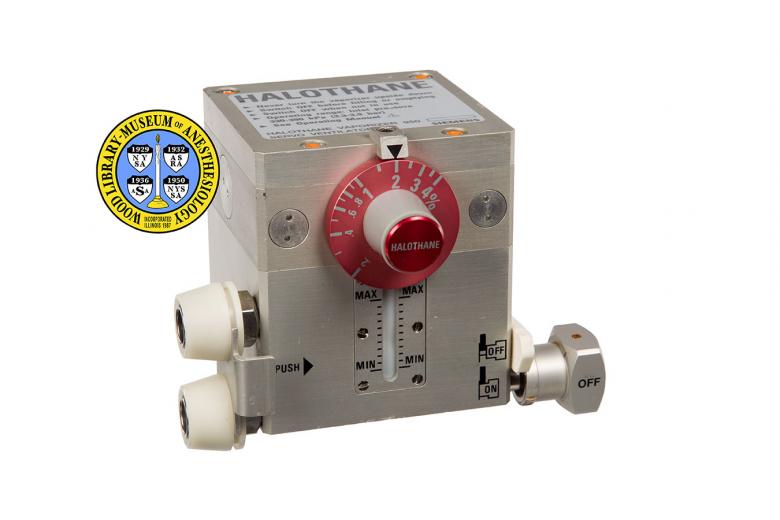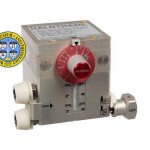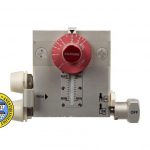Siemens Vaporizer 950
An anesthetic vaporizer is the part of the anesthesia machine that converts a liquid anesthetic into a gas that is delivered to the patient via a 'carrier gas'. The carrier gas is often a combination of other gases, including room air and oxygen. The precise way in which the anesthetic is vaporized into the carrier gas depends on the vaporizer. Unlike ”flow-over” vaporizers, such as the Vapor and Fluotec, in which the carrier gas flows over the liquid anesthetic in a vaporizing chamber, the Siemens vaporizers in this series were “injection vaporizers.” This means that the liquid anesthetic is injected as a fine spray directly into the flowing carrier gas before it is delivered to the patient to inhale. This method of vaporization allowed for the design of smaller and lighter vaporizers.
This line of Siemens vaporizers was introduced during the 1980s. Each vaporizer was made for use with a specific anesthetic. The Siemens Vaporizer 950 was made to vaporize halothane. For safety, a filling system was designed to ensure that only the correct liquid anesthetic could be poured into its corresponding vaporizer. These vaporizers were used with the Siemens Servo Anesthesia System, which included a Servo Ventilator. The Servo line of ventilators was introduced in the early 1970s and was among the first to include built in monitoring capabilities with alarms.
Catalog Record: Siemens 950 Vaporizer
Access Key: akhd
Accession No.: 2006-12-18-1
Title: Halothane vaporizer 950 / Siemens.
Corporate Author: Siemens.
Title variation: Alt Title
Title: Siemens 950 vaporizer.
Title variation: Alt Title
Title: Siemens-Elema AB halothane vaporizer.
Publisher: Sweden : Siemens-Elema AB, [1988-2001].
Physical Descript: 1 vaporizer : metals, plastic ; 10.5 x 14.5 x 14.5 cm.
Subject: Vaporizers.
Subject: Halothane.
Subject: Anesthesia, Inhalation – instrumentation.
Note Type: General
Notes: Years in the range for the possible year of manufacture are based on the
dates of publications in which the vaporizer is mentioned. The date range
could change if documentation indicates the range should be corrected.
Note Type: Citation
Notes: Dorsch JA, Dorsch SE. Understanding anesthesia Equipment: Construction, Care
and Complications. 3rd ed. Baltimore: Williams & Wilkins; 1994:91-105.
Note Type: Citation
Notes: Dorsch JA, Dorsch SE. Understanding anesthesia Equipment: Construction, Care
and Complications. 4th ed. Baltimore: Williams & Wilkins; 1999:131-133.
Note Type: Citation
Notes: Jonson B. Histoire de la Servo-ventilation. Le Centre hospitalier
universitaire (CHU) Albert Chenevier-Henri Mondor website. https://www.
reamondor.aphp.fr/pdf/java07/BJ.pdf. Accessed April 24, 2013.
Note Type: Citation
Notes: Höglund K, Emtell P, inventors; Siemens Elema AB, assignee. Vaporizer. US
patent 6,298,845 B1. October 9, 2001.
Note Type: Citation
Notes: The new Servo anesthesia system from Siemens-Elma. Schaumburg, IL:
Siemens-Elma; 1988.
Note Type: Physical Description
Notes: A vaporizer manufactured to administer halothane; The housing is a metal cube
measuring approximately 9.7 cm in height, 8.8 in width, and 8.8 in depth; A
concentration dial with red (light vermillion) and pink hues is on the front
of the cube marked in increments from .2 to 4 percent; Only even increments
less than 1, and whole increments are numbered; Odd increments less than one,
and half increments greater than one are indicated with a short line; Below
the dial on the front is a filling window, marked vertically in unnumbered
increments from “MIN” to “MAX”; A port for in-flowing carrier gas and a port
for out flowing gas extends from the left side of the vaporizer; An on/off
turn knob extends from the right side of the vaporizer; A red (light
vermillion) colored filling port extends from the back of the vaporizer; A
sticker with manufacturers markings is fixed to the top of the vaporizer; The
text includes, “HALOTHANE”, “Never turn the vaporizer upside down”; “Switch
OFF before filling or emptying”, “Switch OFF when not in use”, Operating
range: Inlet pressure 330-390 kPa (3.3-3.9 bar)”, “See Operating Manual”,
“HALOTHANE VAPORIZER 950”, “SERVO VENTILATOR”, “SIEMENS”; A metal plate fixed
to the back of the vaporizer is marked with the following, “SIEMENS-ELEMA AB”
Model-No. E352E-HV950”, “Serial-No. 3819 S11”, MADE IN SWEDEN”.
Note Type: Reproduction
Notes: Photographed by Mr. Steve Donisch on January 14, 2013.
Note Type: Historical
Notes: An anesthetic vaporizer is the part of the anesthesia system that converts a
liquid anesthetic into a gas that is delivered to the patient via a ‘carrier
gas’. The carrier gas is often a combination of other gases, including room
air and oxygen. The precise way in which the anesthetic is vaporized into the
carrier gas depends on the vaporizer. Unlike ”flow-over” vaporizers, such as
the Vapor and Fluotec, in which the carrier gas flows over the liquid
anesthetic in a vaporizing chamber, the Siemens Vaporizer 950 described here
is an “injection vaporizer.” This means that the liquid anesthetic is
injected as a fine spray directly into the flowing carrier gas before it is
delivered to the patient to inhale. This method of vaporization allowed for
the design of smaller and lighter vaporizers.
Note Type: Historical
Notes: This line of Siemens vaporizers was introduced during the 1980s. Each
vaporizer was made for use with a specific anesthetic. The Siemens 950 was
made to vaporize halothane, the 951: enflurane, and the 952: isoflurane. For
safety, a filling system was designed to ensure that only the correct liquid
anesthetic could be poured into its corresponding vaporizer. These
vaporizers were used with the Siemens Servo Anesthesia System, which included
a Servo Ventilator. The Servo line of ventilators was introduced in the early
1970s and was among the first to include built in monitoring capabilities
with alarms.
Note Type: Exhibition
Notes: Selected for the WLM website.



